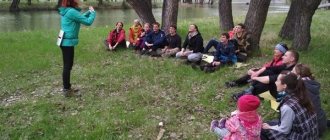Outdoor games, educational and methodological material on the topic
1. Squirrels, mice, hares (11-16 years old)
Game: 15-30 people play. Participants are divided into groups of 5 or 10 players. The leader gives the groups names: squirrels, hares, mice. The driver is selected. 3 hoops are placed at a distance of 5 meters from each other. These are the “houses” of animals. The presenter gives a command, for example, “Squirrels and mice!” The named groups must exchange “houses”. The player caught by the driver becomes the driver, the driver joins the team from which he was caught. The presenter can also give the following signal: “Mice, squirrels, hares!” Then all three teams must leave their house and take any other one.
2. Scouts and sentries (11-16 years old) Preparation: The players are divided into two teams - scouts and sentries - and line up along two opposite sides of the site at a distance of 18-20 m from one another. A line is drawn three steps in front of the ranks, and in the middle, a volleyball is placed in the outlined circle. Players in teams are counted in numerical order. The task of the scout team is to carry the ball over their line, the task of the players of the other team is to prevent this. Game: The presenter loudly calls the number, and the players standing opposite (having this number) run up to the ball. If the sentry is careless, the scout grabs the ball and runs away with it to his house, and the sentry is captured and stands behind the scout. If both players simultaneously run out to the middle, then the scout’s task is to, by performing a series of distracting exercises (arm movements, jumping in place and with a turn, lunges, etc.), divert the attention of the sentry (he repeats after the scout these movements) and carry the ball away. If the scout grabbed the ball, but the sentry overtook him and hit him with his hand, the scout becomes a prisoner, otherwise he wins the duel. The game continues until all numbers have taken part in the game. The prisoners are counted and released to their teams. The game is repeated, with the players changing roles. As a result, victory was on the side of the team that managed to take more prisoners. The rules of the game oblige the sentry to repeat all the movements of the scout, otherwise he loses. You can only chase a fleeing player to the edge of his house. The player who drops the ball is considered caught. Each time the scout puts the ball in place.
3. Day and night (8-16 years old)
All players are divided into two teams. One team is “day”, the other is “night”. A presenter is selected. Two sets of caps, black and white, are prepared according to the number of participants. “Day” wears white caps, and “night” wears black caps. Each player carries a cap of the opposite color. The presenter shouts: “Day!” and the corresponding team catches the playing teams “Night”. Those caught put on white caps and move to another team. Then vice versa. The alternation of day and night should be uniform. The team with the most players at the end of the game wins.
4. Bird migration (8-16 years old)
The players are divided into two teams. Each is a flock of birds. The leader - the hunter - is selected. The flocks must stand on opposite sides of the hunter (on different sides of the playing field). Each player comes up with a name for any bird (the hunter should not know who has what name). The hunter then calls out the name of any bird. If there is one on the team, then it must fly to another team so that the hunter does not catch it. If the named birds are in both teams, then they change places. The bird that the hunter caught becomes the leader (or simply drops out of the game).
5. Monkeys (6-16 years old)
The presenter says the words: “We are funny monkeys, we play too loud. We clap our hands, we stomp our feet, we puff out our cheeks, we jump on our toes and we even show each other our tongues. Let's jump together to the ceiling, bring our finger to our temple. Let's stick out the ears and the tail on the top of the head. We'll open our mouths wider and make grimaces. When I say the number 3, everyone freezes with grimaces!” The players repeat everything after the leader.
6. Brook (8-16 years old)
Game: Players form pairs, hold hands and raise them up to form a gate. The gates stand one after the other at a distance of a step. One or more participants go under the gate and choose a pair by breaking the gate. A pair of new gates, passing under all the gates, stand at the end of the column. The remaining half chooses a new one. And so on in a circle.
7. Little Engine (6-16 years old)
Everyone becomes a train and begins to move forward to the music. The presenter abruptly turns off the music, everyone must stop. Whoever at the same time “knocked down” the person in front or broke away from everyone else is eliminated. For convenience, there can be two presenters: the one who is responsible for the music, and the one who drives the “locomotive”. The more people, the better. It cannot be done without landfills. The main thing is to choose the right music and not make even intervals between switching off.
8. Sly fox (6-16 years old)
The players stand in a circle and close their eyes. The driver goes around the circle and imperceptibly touches one of the players - this is a sly fox. Everyone opens their eyes and shouts “Sly fox, where are you?” three times. After the third time, everyone runs away, and the fox tries to catch up with someone. The one whom the fox caught becomes the driver.
9. Candles (8-16 years)
Players choose a leader who will “light them up”, that is, salt them. The emboldened player must answer the host's question or riddle while he counts to three. If the player does not answer, then he “burns out”. This is how the longest “candles” are identified. *When playing this game, you don’t have to run, but sit in a circle. Then questions are asked to everyone in turn, but the count to three is maintained.
10. Birds. (8-16 years old)
Children choose “mistress” and “hawk” according to a counting rhyme, the rest choose “birds”. The “mistress” secretly from the “hawk” gives a name to each bird. A “hawk” flies in and begins negotiations with the “mistress”:
- What did you come for?
- For the bird.
- For which?
A hawk calls, for example, a cuckoo. The cuckoo runs out and the hawk catches it. If the bird named hawk is not there, the owner drives it away. The game continues until the hawk catches all the birds.
The hawk can only chase the bird after it crosses the line and runs across the area. The caught bird does not play until the end of the game.
11. I am a snake, snake, snake (11-16 years old)
Participants stand in a circle, one after another - a boy, a girl. The counselor begins by approaching someone with the words: “I am a snake, snake, snake, do you want to be my tail?” If the answer is yes, then the person being asked crawls under the leader’s feet, introduces himself, and with his right hand takes the person being asked’s left hand through his legs. If the answer is negative, the phrase sounds: “But you have to!”, and the clutch begins. Thus, each time the snake grows larger and larger. The game continues until all participants join each other.
12. Jungle (8-16 years old)
The players are divided into three teams: blue, green and red. Each team member wears a headband of the corresponding color. The game is played in a limited area, but not indoors; the bandages (color) cannot be changed; if you get dirty, then give the bandage back without resistance.
Blues catch greens, greens catch reds, reds catch blues. Teams should be released at intervals to allow the previous team to escape. Give the selected bandages to the presenter. The team that catches its victims the fastest wins.
13. Dragon's head (11-16 years old) The players cling to each other like a train. At the command of the leader, the head of the dragon - the first person - tries to catch the tail - the last person. He, in turn, must dodge. When the last one is caught, it moves to the beginning of the chain.
14. Fishing rod (6-16 years old) Participants stand in a circle. The leader stands with a jump rope or rope, at the end of which a bag of sand is tied. The leader spins the fishing rod in a circle, and the participants must jump, trying not to hit it.
15. Frost-Red Nose (11-16 years old) Two houses are designated on opposite sides of the site, the players are located in one of them. The driver, Frost-Red Nose, stands in the middle of the platform. He says:
I am Frost the Red Nose.
Which one of you will decide
Set off on a path? .
The players answer:
We are not afraid of threats
And we are not afraid of frost.
After this, the children run across the playground to another house. Frost catches up with them and tries to freeze them (touch them with your hand). The frozen ones stop at the place where the Frost overtook them and stand until the end of the run. After several dashes, another driver is chosen.
16. Neighbor on the right (11-16 years old) All participants in this fun game sit in a circle. The driver stands in the center of the circle. Addressing first one or the other of the players, the driver asks each of them some question or asks them to perform some movement: stand up and turn around in place or clap their hands three times, etc. But answer the question asked or It is not the one to whom the driver is addressing who must perform the required movement, but his neighbor on the right, whom the driver does not even look at. Having received the answer, the driver immediately turns to another, to a third, and so on, until one of the players makes a mistake.
A question is asked (or a task is given) quickly and suddenly. Just as quickly you need to give an answer (or perform the required movement). If a question is asked that is difficult to answer immediately, then you can say: “I don’t know,” which is already the answer, but do not remain silent.
It would seem that these rules are very simple and easy to remember, but in the game they are often violated due to the suddenness with which the driver addresses the participants in the game. Either the one to whom the question is addressed answers it himself, or the neighbor on the right will be confused by surprise and will not immediately realize that he is supposed to be the one to answer. Whoever breaks the rule will have to give up his place in the circle to the driver and give a forfeit.
17. Traffic lights. (8-16 years old) After the driver is chosen, everyone stands on one side of him at a distance of five steps. The driver turns away from the players and names any color. Participants must find this color in their clothes, and holding onto it, they can freely move to the other side. The one who does not have this color must run across so as not to be caught. Whoever gets caught becomes the driver.
18. Four elements (11-16 years old) The players stand in a circle, with the leader in the middle. He throws the ball to one of the players, while pronouncing one of four words: “earth”, “fire”, “water”, “air”. If it says “land,” the one who caught the ball must quickly name some domestic or wild animal. When you hear the word “water,” the player names a fish. When the word “air” is heard, the player must give the name of the bird. When you hear the word “fire,” everyone needs to turn around several times, waving their arms. The ball is then returned to the driver. The one who makes a mistake is out of the game
19. Squirrels, Nuts, Cones (11-16 years old) All the guys stand up, holding hands, three at a time, forming a “squirrel’s nest.” They agree among themselves who will be the “squirrel,” who will be the “nut,” and who will be the “bump.” The driver is alone, he does not have a nest. There is also a presenter in this game who pronounces the words: “squirrels”, “cones”, “nuts”. If he said “squirrels,” then all the squirrels leave their nests and run to others. At this time, the driver takes an empty space in any nest, becoming a squirrel. The one who does not have enough space in the nests becomes the leader. If the leader says: “nuts,” then the nuts change places and the leader, who took a place in the nest, becomes a nut. The driver and presenter can be different people, or both functions can be performed by one person. The presenter can be given the command: “squirrels, cones, nuts,” and then everything changes places at once.
20. Cry of quality (14-16 years old) At the very beginning, participants are divided into pairs with those people whom they see for the first time. Participants are asked to identify 1 quality in themselves that they would like to have more of and share it with their partner. The partners are then separated in a field at a distance of 50-10 m. Participants are blindfolded and asked to find their partner by shouting out the quality that their partner would like to have more of. Starting at the announced time, competitors move across the field, listening to what their partners are shouting. Such qualities as patience, strength, trust, fun always resonate on the field and create an atmosphere of a person’s desire for excellence. The qualities that the participants identify then become an area for the leader to help the participant develop.
21. Firefighters (11-16 years old)
The chairs are placed in a circle, with their backs inward. While the music is playing, the children run, when the music stops, everyone stands in front of their chair and takes off one thing. They run further. Stop. They leave their second item on another chair. Then the third. After this, the command is given: “Fire”, everyone must collect their things as quickly as possible. It's good to play on the beach.
22. Change of Places (The Wind Blows On Togo) (11-16 years old)
The players sit in a circle facing inward, with the driver standing in the center. Seating must be precisely defined, and their number must match the number of players. The driver forces some of the players to randomly change places, saying: “Swap places those who have ...” and names some feature, for example, striped pants. After which, all players corresponding to this sign stand up and change places. The driver’s task is to manage to sit in one of the empty seats in the general chaos. The one who ultimately does not have enough space becomes the driver.
23. Crocodiles (8-16 years old) The squad is divided into two equal teams. The first team comes up with some cool word and chooses a person from the other team who will have to “show” this word. Moreover, this player is prohibited from making sounds and writing letters, but he uses active gestures, breathtaking facial expressions, antics, obscene body movements, and so on, depending on the player’s imagination. His team tries to understand the meaning of what is shown and gives answer options. It is important to select as many synonyms as possible, then the probability of guessing increases linearly. After guessing/not guessing, the teams change roles.
Hide and seek
Children's games on the street should captivate the participants. One such classic but timeless game is hide and seek (hide and seek). A driver is selected (children have many rhymes for this), and the place where everyone will be “caught” is also determined. The order of the game is as follows:
- The driver counts to 5 with his eyes closed and warns that he is going to look.
- Players must have time to hide.
- If the driver has found the player, then they race to the place that was chosen in advance in order to “catch” or “catch” the one they found. If the player managed to pat the place, then he is not considered discovered.
- The game is over when everyone is found.
"Stander"
Looking for fun street games for kids? A fun ball game that will test your eye accuracy:
- All players stand around the player with the ball.
- He throws the ball and shouts, calling the name of one of his friends: “Stander, Sasha!”
- This Sasha must catch the ball and freeze.
- The driver looks around and determines by eye the distance in steps to the person who caught the ball. They are agreed upon in advance: these will be ordinary steps, Lilliputian steps (putting their feet down) or giant steps (as wide as possible). These types can be combined by agreement. The main thing is that at the end the driver can reach his friend.
If the conditions are met, the drivers change.
"Predators and Herbivores"
In a group of children, a “predator” is chosen, while the rest of the children are “herbivores.” A circle with a diameter of up to 2.5 m is drawn on the ground to accommodate all participants in the game:
- Everyone runs around the yard.
- The “predator’s” task is to catch up with someone and lead them into a circle.
- Then the task becomes more complicated, because he will not only have to catch new players, but also make sure that those already in the circle are not released. To do this, one of the free “herbivores” just needs to run close and extend a hand to the trapped victim.
- The game ends with either everyone being free or everyone falling into a trap.
Summer games using crayons
Summer Game Chalk Snail
Age : 3-7 years.
Number of players: 1-3.
What develops : memory, visual and motor coordination, eye, dexterity.
What you will need : crayons.
Description : Draw hopscotch on the asphalt in the shape of a snail (a spiral-twisted path, lined into squares). Inside you can write numbers, letters, days of the week, names of planets, etc. depending on what needs to be learned. The child jumps across the squares on two legs forward and backward. You can make the game more difficult by asking your child to jump on one leg. If there is more than one participant, then the children jump in turns.
Summer game using chalk Hopscotch
Age : 3-7 years.
Number of players: 3-5.
What develops : visual and motor coordination, eye, dexterity.
What you will need : crayons, small stones.
Description : Draw the usual classics on the asphalt. The player throws a stone with his hand (or foot) onto the square with numbers and jumps on it with both feet, then moves the stone to the next square and jumps onto it. The stone must not stop on the line. Children jump in turns, the one who can complete the hopscotch first (or the one who completes the hopscotch in the least number of movements) wins.
Unusual classics
Age : 3-5 years.
Number of players: 1-2.
What develops : memory, visual and motor coordination, eye, dexterity.
What you will need : crayons.
Description : Draw the usual classics on the asphalt, but draw geometric shapes inside the squares. Possible task options: jump on figures of a certain shape, for example, triangles; jump only on quadrangles (rhombus, square, rectangle, etc.); jump only on those figures that the leader calls; jump and name the piece yourself; jump on figures without corners and more.
Outdoor game Labyrinth
Age : 3-5 years.
Number of players: 3-5.
What develops : visual and motor coordination, eye, dexterity.
What you will need : crayons.
Description : Draw a labyrinth on the asphalt (the shape can be changed depending on the age and skills of the child). You need to run through the maze without stepping on the lines, trying to find a way out in less time. You can play tag, blind man's buff, etc.
Summer game Hit the figure
Age : 3-5 years.
Number of players : 5 or more.
What develops : visual and motor coordination, eye, dexterity, accuracy, ability to throw objects at a target.
What you will need : crayons, pebbles (cones, short sticks).
Description : Draw any shapes (circle, square), there should be as many of them as there are participants. These will be targets. Each player needs to hit his piece with a cone (stick, pebble), and the objects should not be on the line. The one with the most items inside the target wins.










